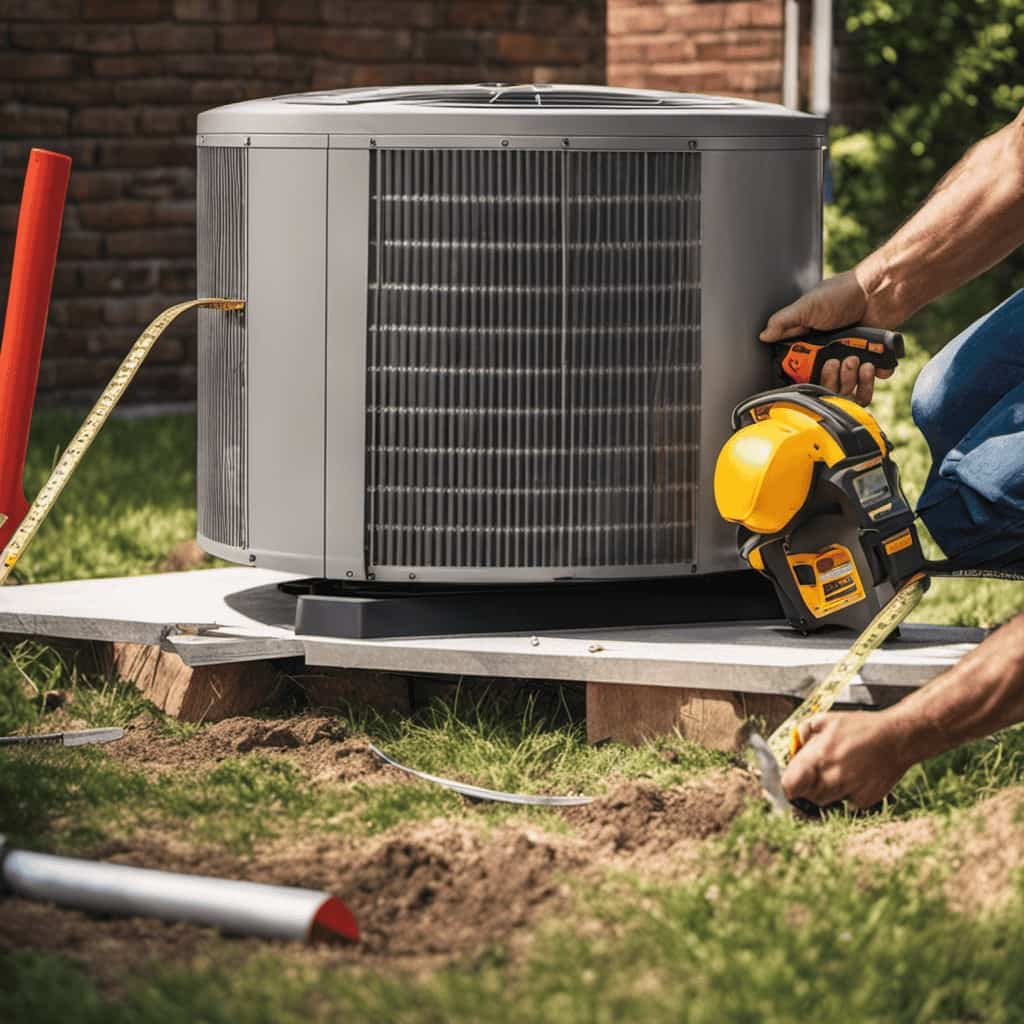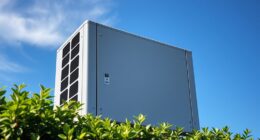Looking for ways to improve the thermal energy transfer efficiency of your heat pump? Look no further!
In this article, we will guide you through the key steps to achieve optimal performance.
From understanding the basics of thermal energy transfer to selecting the right components, we’ll provide you with the knowledge you need to design a heat pump that serves you and your energy needs.
Let’s dive in and unlock the secrets of efficient thermal energy transfer!

Key Takeaways
- Proper heat pump sizing is essential for maximizing energy efficiency and reducing operating costs.
- Regular inspection and cleaning of heat pump components, including the heat exchanger, ensure efficient heat transfer.
- The choice of refrigerant directly impacts the effectiveness and efficiency of thermal energy transfer.
- Design enhancements, such as increasing surface area and using materials with higher thermal conductivity, can improve heat exchanger performance and overall heat pump system performance.
Understanding the Basics of Thermal Energy Transfer in Heat Pumps
Let’s start by exploring the fundamentals of thermal energy transfer in heat pumps.
When it comes to heat pump maintenance and troubleshooting heat pump issues, understanding how thermal energy transfer works is crucial.
Heat pumps transfer thermal energy from one location to another by utilizing a refrigerant and a compressor.
The refrigerant absorbs heat from a low-temperature source, such as the outdoor air or ground, and then passes through the compressor, where the temperature and pressure increase.

This high-temperature, high-pressure refrigerant then releases the absorbed heat into the indoor space.
To ensure optimal thermal energy transfer, it’s important to regularly inspect and clean the heat pump components, including the coils, filters, and fans.
Troubleshooting heat pump issues involves checking for refrigerant leaks, electrical connections, and proper airflow.
Importance of Proper Heat Pump Sizing for Optimal Thermal Energy Transfer
Proper heat pump sizing is essential for achieving optimal thermal energy transfer. When it comes to heat pump design, one can’t underestimate the importance of getting the sizing right.

Here are some key reasons why proper heat pump sizing is crucial for optimal thermal energy transfer:
-
Energy Efficiency: A properly sized heat pump ensures that it operates at its peak efficiency, maximizing energy savings and reducing operating costs.
-
Comfort: Proper sizing ensures that the heat pump adequately heats or cools the space, providing optimal comfort levels.
-
Reduced Wear and Tear: Oversized or undersized heat pumps can lead to increased wear and tear, shortening the lifespan of the unit.

-
Heat Pump Insulation: Proper sizing takes into account the insulation of the space, ensuring that the heat pump can effectively transfer thermal energy without any losses.
Key Components and Their Role in Thermal Energy Transfer in Heat Pumps
The compressor plays a crucial role in the thermal energy transfer process within a heat pump. It’s responsible for increasing the pressure and temperature of the refrigerant, allowing for efficient heat exchange.
Heat exchanger efficiency is another key component that affects thermal energy transfer. A well-designed and properly sized heat exchanger ensures maximum heat transfer between the refrigerant and the surrounding environment.
Additionally, the choice of refrigerant is of utmost importance as it directly impacts the efficiency and effectiveness of thermal energy transfer in heat pumps.
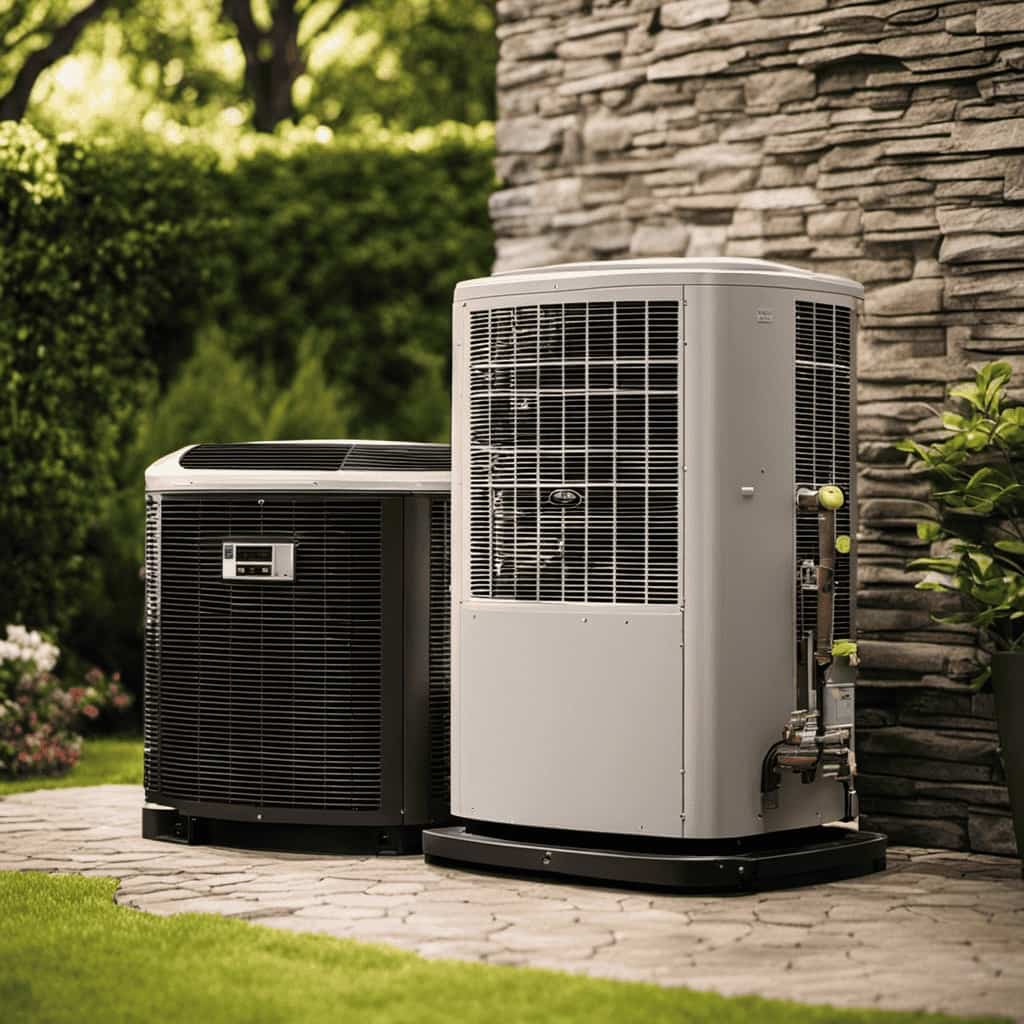
Compressor’s Role in Transfer
Our compressor plays a crucial role in transferring thermal energy efficiently in heat pumps. It’s responsible for compressing the refrigerant, which increases its temperature and pressure, allowing it to absorb heat from the surroundings.
Here are some key components and their roles in thermal energy transfer:
-
Compressor efficiency: The efficiency of the compressor affects the overall performance of the heat pump. A more efficient compressor can transfer thermal energy more effectively, resulting in lower energy consumption and higher system performance.
-
Refrigerant properties: The choice of refrigerant is essential for optimal thermal energy transfer. Refrigerants with high heat transfer coefficients and low boiling points can enhance the heat pump’s efficiency by facilitating faster heat absorption and release.

-
Motor: The compressor’s motor powers the compression process, allowing the refrigerant to circulate and transfer thermal energy. The motor’s efficiency and power output impact the overall efficiency and performance of the heat pump.
-
Pressure relief valve: This safety component ensures that the compressor doesn’t exceed its maximum pressure limit, preventing damage to the system and ensuring safe operation.
Heat Exchanger Efficiency
To achieve optimal thermal energy transfer in heat pumps, we must understand the key components and their role in heat exchanger efficiency.
The heat exchanger is a critical component that plays a vital role in the overall performance of a heat pump system. It’s responsible for transferring heat between the refrigerant and the surrounding medium, whether it be air, water, or another fluid.

Maintaining the heat exchanger is essential for ensuring its efficiency over time. Regular heat exchanger maintenance, such as cleaning and inspection, can help prevent fouling and blockages that can impede heat transfer.
Additionally, improving heat exchanger performance can be achieved through design enhancements, such as increasing the surface area for heat transfer or using materials with higher thermal conductivity.
Importance of Refrigerant
One of the key components that plays a crucial role in thermal energy transfer in heat pumps is the refrigerant. Proper refrigerant selection is essential for achieving optimal heat pump performance. The refrigerant properties determine its ability to absorb and release thermal energy efficiently.
Here are some important factors to consider when choosing a refrigerant:
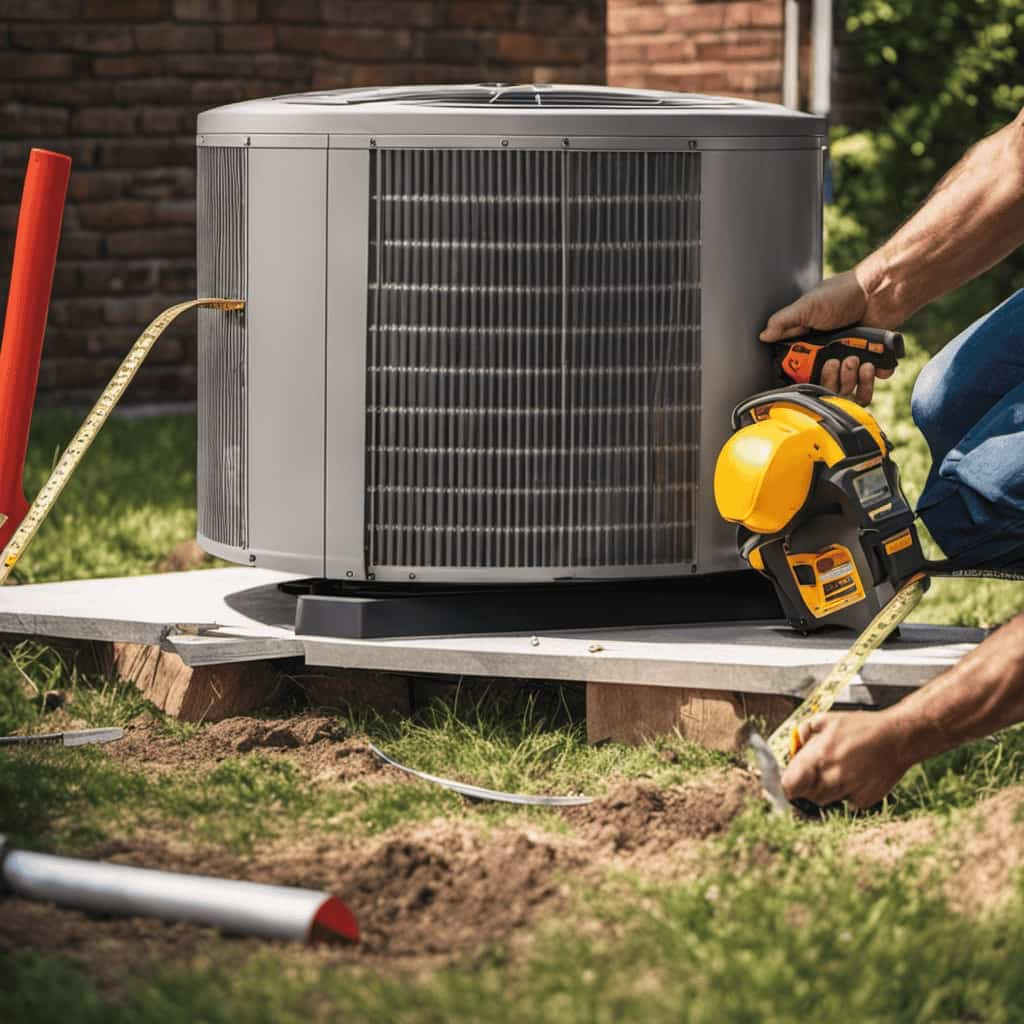
-
Thermodynamic properties: The refrigerant should have a high heat capacity and low boiling point to facilitate efficient heat transfer.
-
Environmental impact: It’s important to select a refrigerant with low global warming potential (GWP) and ozone depletion potential (ODP) to minimize environmental harm.
-
Safety considerations: The refrigerant should have low toxicity and flammability to ensure safe operation.
-
Compatibility with system components: The refrigerant should be compatible with the heat pump’s components, such as the compressor, condenser, and evaporator, to prevent damage and ensure long-term reliability.
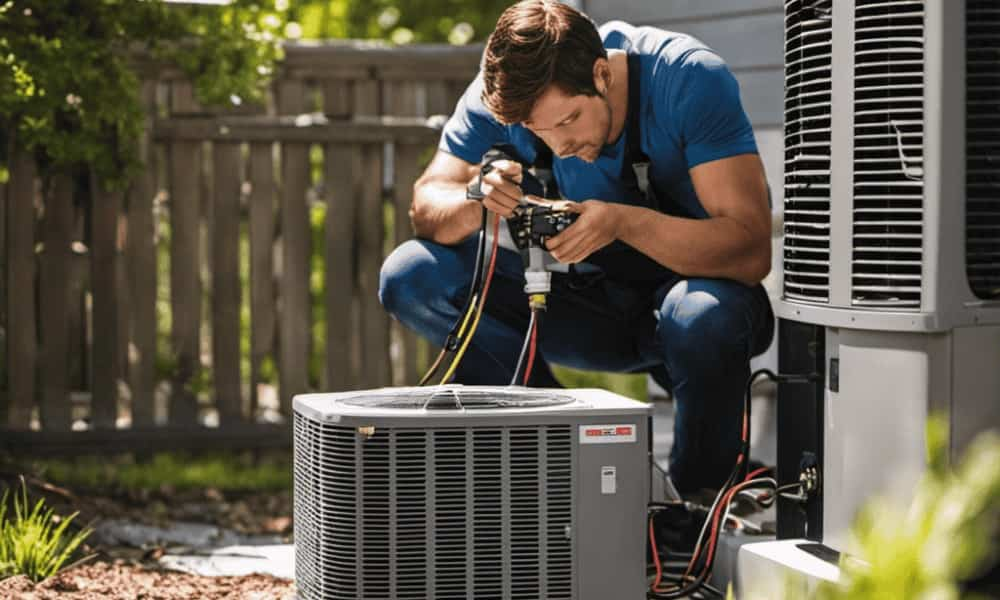
Proper refrigerant selection based on these factors is crucial for achieving optimal thermal energy transfer and maximizing the efficiency of heat pump systems.
Optimizing Heat Exchanger Design for Efficient Thermal Energy Transfer
We can optimize heat exchanger design by considering factors such as surface area, fluid flow rate, and material conductivity. Heat exchangers play a crucial role in efficient thermal energy transfer in heat pump systems.
The choice of heat exchanger materials is essential for achieving optimal performance. Materials with high thermal conductivity, such as copper or aluminum, are commonly used due to their ability to efficiently transfer heat.
Additionally, the design should aim to maximize the surface area available for heat exchange to enhance the transfer efficiency. This can be achieved through the use of finned tubes or extended surfaces.

Furthermore, the fluid flow rate within the heat exchanger should be carefully controlled to ensure efficient heat transfer.
Selecting the Right Refrigerant for Enhanced Thermal Energy Transfer
When selecting a refrigerant for enhanced thermal energy transfer, it’s crucial to consider its thermodynamic properties and environmental impact. The right refrigerant can greatly optimize thermal conductivity, resulting in improved performance and energy efficiency.
Here are some key factors to consider in refrigerant selection for thermal conductivity optimization:
-
Thermodynamic properties: Look for refrigerants with high heat transfer coefficients and low boiling points to maximize thermal energy transfer.
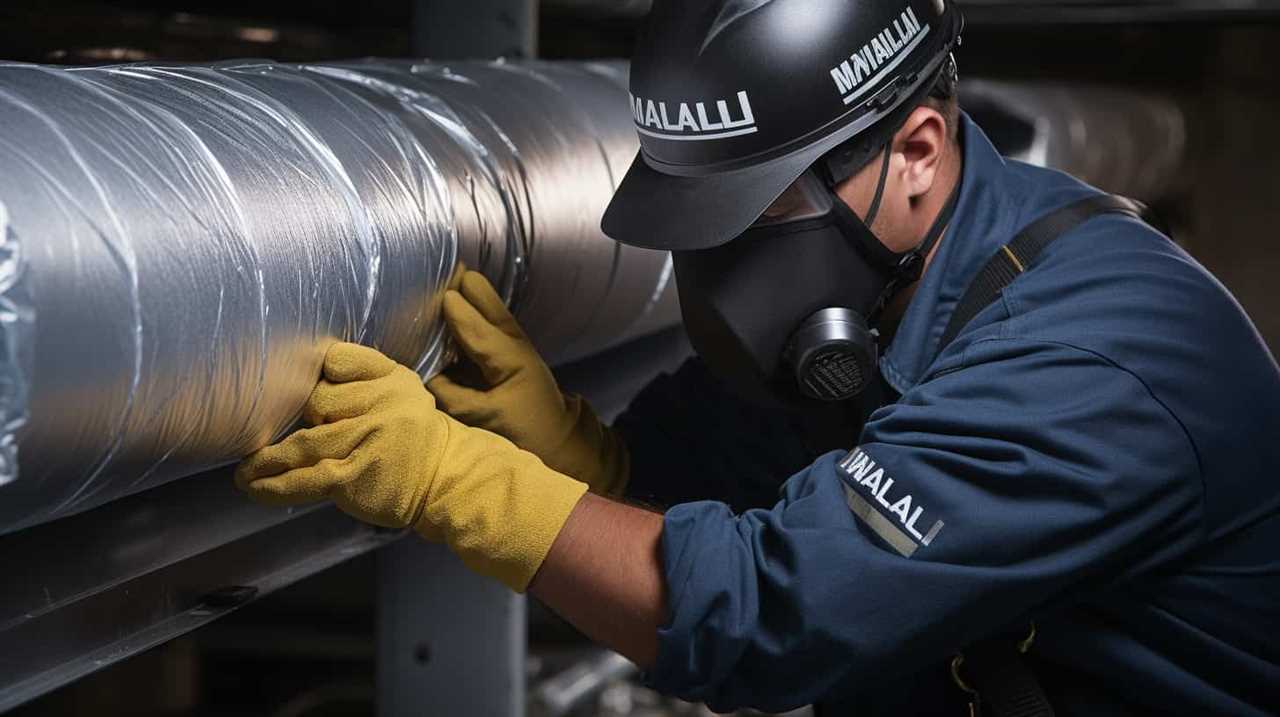
-
Compatibility: Ensure the selected refrigerant is compatible with the heat pump system components to avoid any operational issues.
-
Environmental impact: Choose refrigerants with low global warming potential (GWP) and ozone depletion potential (ODP) to minimize the ecological footprint.
-
Safety: Consider the flammability and toxicity properties of the refrigerant to ensure the safety of the system operators and users.
Strategies for Minimizing Heat Loss in Heat Pump Systems
How can we effectively minimize heat loss in heat pump systems?

One of the key strategies is to focus on heat pump insulation. By properly insulating the heat pump and its components, we can significantly reduce heat loss and improve overall energy efficiency. This can be achieved by using high-quality insulation materials and ensuring proper installation techniques.
Additionally, implementing minimizing heat loss techniques such as sealing any air leaks or gaps in the system can further enhance its performance.
It’s also important to consider the placement of the heat pump and its exposure to external elements, as this can impact heat loss.
Maximizing Heat Transfer Surface Area for Improved Thermal Energy Transfer
To maximize thermal energy transfer, it’s crucial to regularly clean and maintain the heat transfer surfaces of the heat pump. By doing so, we can ensure optimal heat pump efficiency and improve overall system performance.

Here are some key factors to consider in maximizing heat transfer surface area for improved thermal energy transfer:
-
Surface Cleanliness: Regularly cleaning the heat transfer surfaces removes any dirt, debris, or scaling that could hinder heat transfer and reduce efficiency.
-
Surface Coatings: Applying a high thermal conductivity coating to the heat transfer surfaces can enhance heat transfer by improving the surface’s ability to conduct heat.
-
Surface Expansion: Increasing the surface area of the heat transfer surfaces, such as using fins or extended surfaces, can maximize heat transfer by providing more contact area for heat exchange.

-
Surface Material Selection: Choosing materials with high thermal conductivity factors for the heat transfer surfaces can enhance heat transfer efficiency.
The Impact of Airflow on Thermal Energy Transfer in Heat Pumps
Proper airflow is crucial for maximizing thermal energy transfer in heat pumps. By ensuring that air is efficiently directed over the heat transfer surfaces, we can optimize the heat exchange process.
Techniques such as using properly designed fans, optimizing ductwork, and implementing variable speed drives can enhance airflow efficiency and improve overall system performance. These measures contribute to maximizing the thermal energy transfer capabilities of heat pumps, resulting in higher efficiency and greater energy savings.
Importance of Proper Airflow
We must ensure sufficient airflow within heat pumps to maximize thermal energy transfer efficiency. Proper airflow management and ventilation techniques are essential for the optimal operation of heat pumps. Here are some key reasons why airflow is crucial for thermal energy transfer:
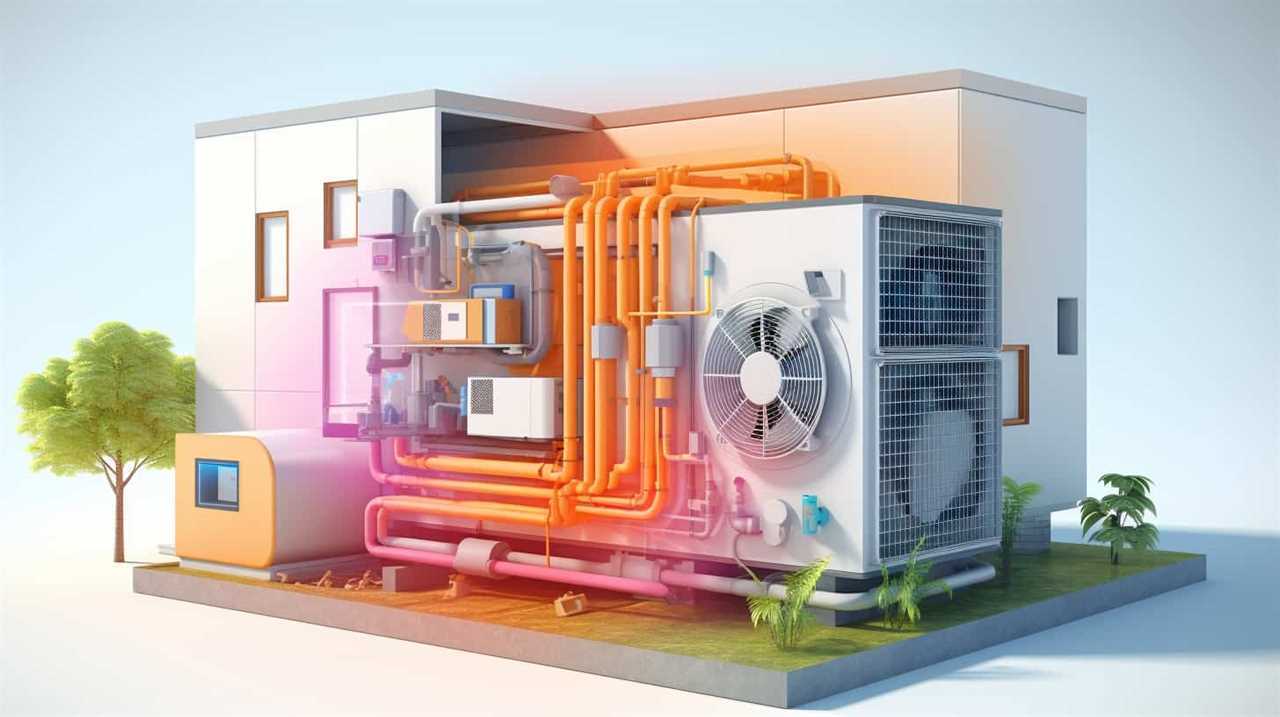
-
Heat exchange efficiency: Adequate airflow allows for efficient heat transfer between the evaporator and condenser coils, ensuring optimal performance of the heat pump.
-
Heat dissipation: Sufficient airflow helps in dissipating the heat generated during the heat pump’s operation, preventing overheating and ensuring its longevity.
-
Air quality control: Proper airflow helps in maintaining good indoor air quality by facilitating the removal of pollutants and ensuring proper ventilation.
-
Frost prevention: Adequate airflow prevents frost accumulation on the evaporator coil, enhancing the heat pump’s efficiency and preventing potential damage.
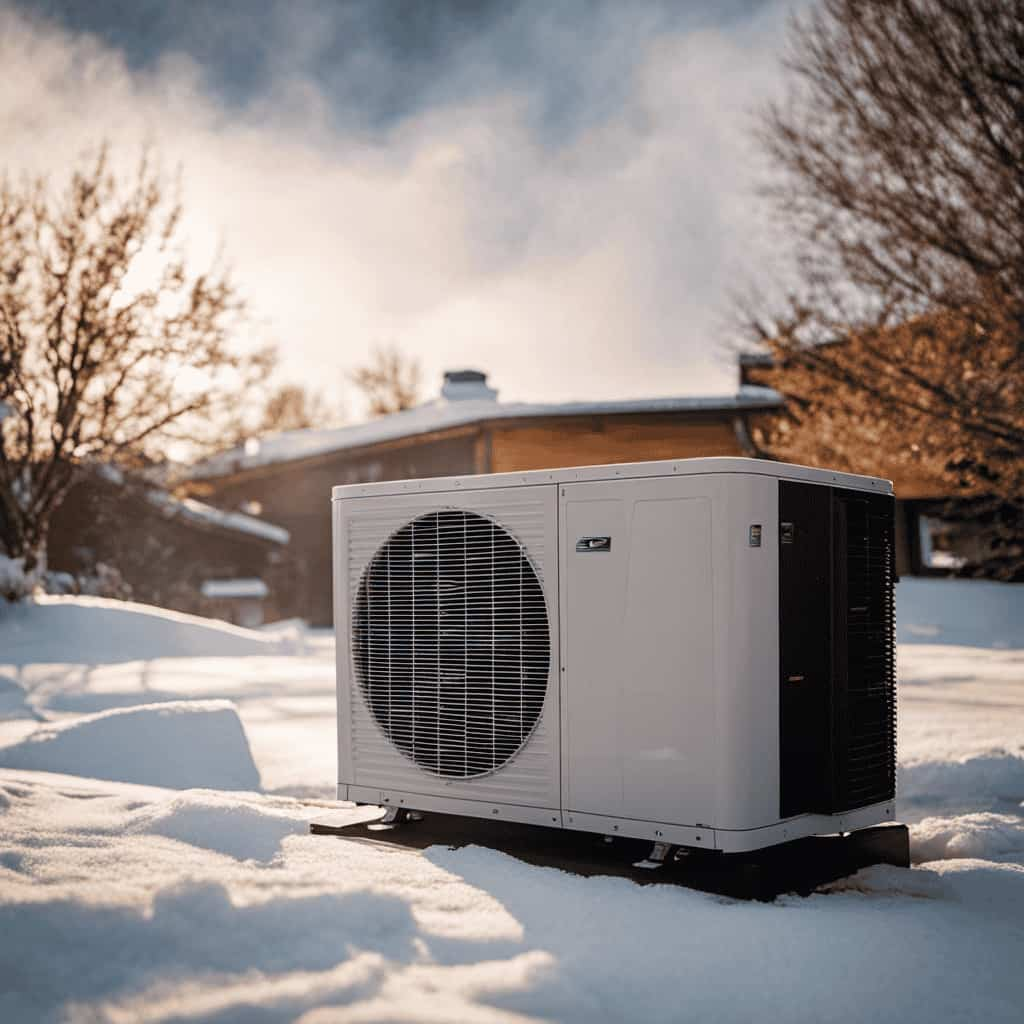
Airflow Efficiency Techniques
By optimizing airflow and implementing effective ventilation strategies, we can significantly enhance the thermal energy transfer capabilities of heat pumps. Airflow management plays a crucial role in ensuring optimal heat pump performance and efficiency. Proper airflow helps to remove heat from the system, preventing heat buildup and improving the overall heat transfer process.
One important aspect of airflow management is heat pump insulation. Insulation helps to minimize heat loss or gain during the heat transfer process, ensuring that the desired temperature is maintained. It also helps to reduce energy consumption and improve the system’s ability to maintain a consistent temperature.
Maximizing Thermal Energy Transfer
To effectively maximize thermal energy transfer in heat pumps, it’s essential to consistently and strategically monitor and adjust the airflow. By optimizing the airflow, we can enhance heat pump efficiency and improve overall performance.
Here are some key considerations for maximizing thermal energy transfer:

-
Maintain proper airflow: Ensuring a steady flow of air through the heat pump is crucial for efficient heat transfer. Regularly clean and inspect the filters to prevent blockages that can impede airflow.
-
Optimize fan speed: Adjusting the fan speed can help achieve optimal heat transfer. Higher speeds can increase heat exchange, but they may also consume more energy. Finding the right balance is essential.
-
Control air direction: Properly directing the airflow can improve heat pump performance. By redirecting the air towards the heat exchanger, we can enhance heat transfer and maximize efficiency.
-
Consider ductwork design: The design and layout of the ductwork can significantly impact thermal energy transfer. Ensure that the ducts are properly sized and insulated to minimize heat loss and maximize transfer efficiency.

Balancing Temperature Differentials for Optimal Thermal Energy Transfer
Achieving a balanced temperature differential is crucial for optimizing thermal energy transfer in heat pump design. Balancing temperature gradients ensures that the heat pump operates at its highest efficiency, maximizing heat transfer from the heat source to the heat sink.
When the temperature differential is too high, it can result in decreased performance and reduced energy efficiency. On the other hand, if the temperature differential is too low, it can lead to inadequate thermal energy transfer and inefficient operation of the heat pump.
To achieve optimal thermal energy transfer, it’s important to carefully consider and design the heat exchangers, refrigerant flow rates, and control systems, ensuring that the temperature differentials are balanced for optimal heat pump performance. By balancing the temperature gradients, we can ensure efficient heat transfer and maximize the overall performance of the heat pump system, ultimately leading to optimal thermal energy transfer.
In the next section, we’ll discuss the importance of maintaining and monitoring heat pump efficiency for long-term thermal energy transfer.
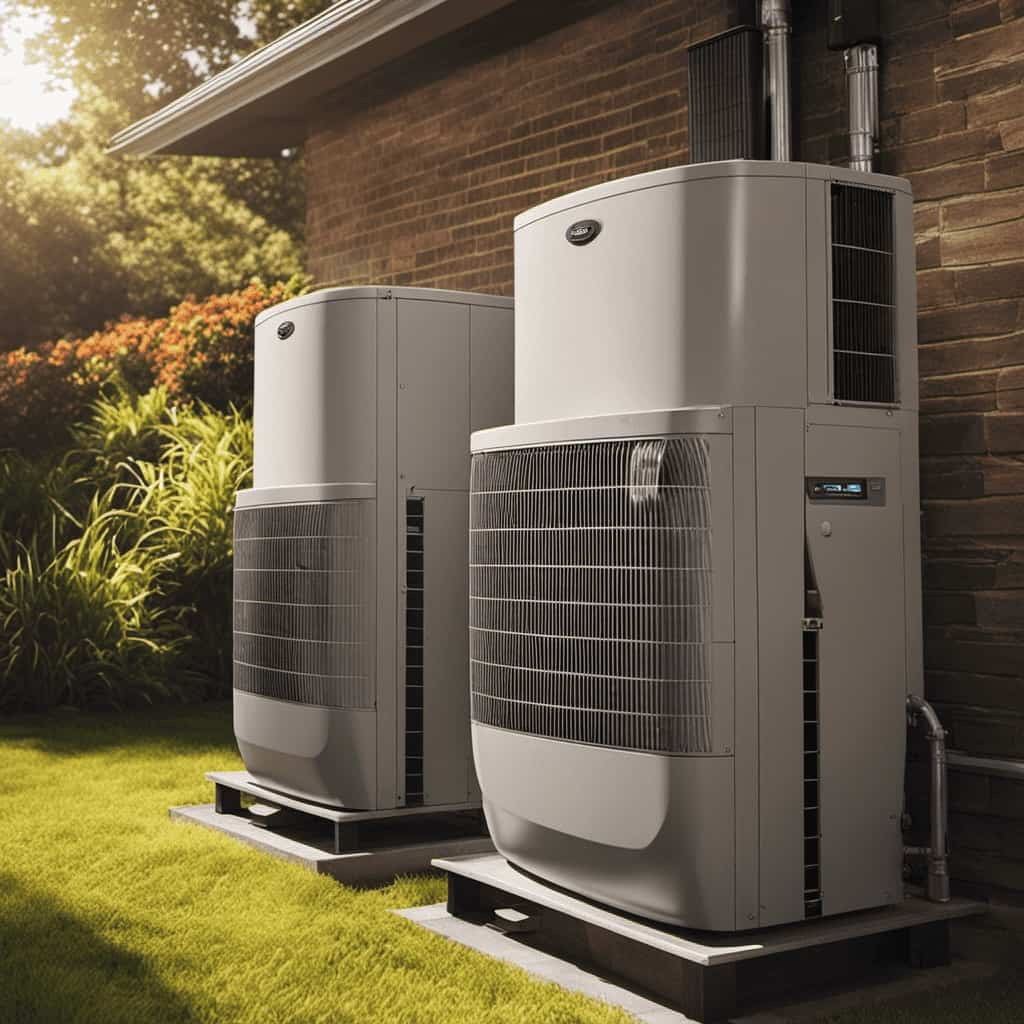
Maintaining and Monitoring Heat Pump Efficiency for Long-Term Thermal Energy Transfer
We can ensure long-term thermal energy transfer by regularly maintaining and monitoring the efficiency of our heat pump system. Proper heat pump maintenance is essential for maximizing energy efficiency and minimizing potential issues. Here are some key steps to consider:
- Regularly clean and replace air filters to ensure proper airflow and prevent dust build-up.
- Schedule routine inspections and maintenance by a qualified technician to identify and address any potential issues.
- Monitor and adjust refrigerant levels to optimize heat transfer efficiency.
- Keep outdoor units clear of debris and maintain proper airflow around the unit.
By following these maintenance practices, we can ensure that our heat pump operates at peak efficiency, maximizing thermal energy transfer and reducing energy consumption.
Regular monitoring and maintenance not only prolong the lifespan of the heat pump but also contribute to a more sustainable and cost-effective heating and cooling system.
Frequently Asked Questions
How Does the Size of a Heat Pump Affect Its Thermal Energy Transfer Efficiency?
The size of a heat pump directly affects its thermal energy transfer efficiency. By carefully selecting the appropriate heat pump size, we can optimize the system’s performance and ensure efficient and effective heat transfer.
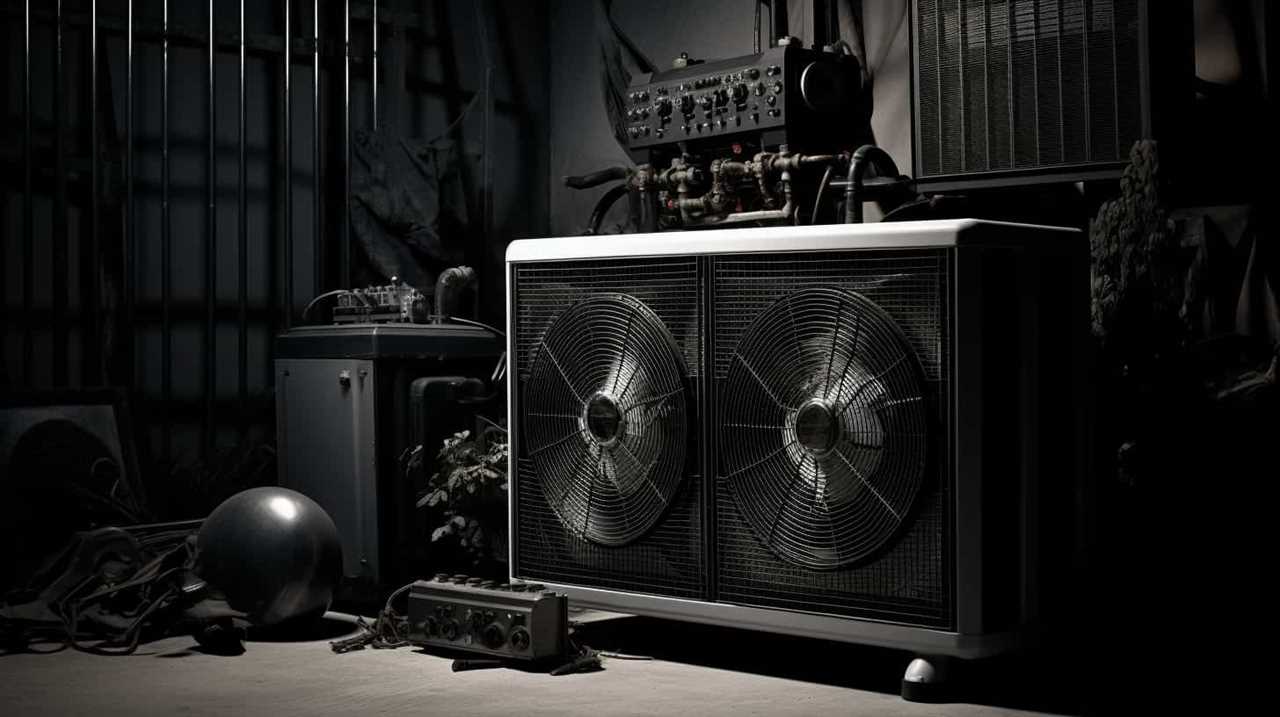
What Are the Main Components of a Heat Pump and How Do They Contribute to Thermal Energy Transfer?
To achieve optimal thermal energy transfer, the main components of a heat pump, such as the compressor, evaporator, and condenser, work together to efficiently transfer heat from a lower temperature source to a higher temperature sink.
Which Refrigerant Is the Best Choice for Maximizing Thermal Energy Transfer in a Heat Pump?
The best refrigerant for maximizing thermal energy transfer in a heat pump depends on factors such as heat pump size and desired efficiency. It is important to choose a refrigerant that has a high heat transfer coefficient and low environmental impact.
What Are Some Strategies for Minimizing Heat Loss in a Heat Pump System?
To minimize heat loss in a heat pump system, we must prioritize insulation in our design. Proper insulation is crucial for optimal thermal energy transfer and ensuring efficient operation.
How Can Airflow Impact Thermal Energy Transfer in Heat Pumps and What Can Be Done to Optimize It?
Airflow plays a crucial role in thermal energy transfer in heat pumps. By optimizing airflow, we can maximize heat transfer efficiency. Insulation impacts heat loss, while the condenser’s role is to release heat to the surrounding environment.

Conclusion
In conclusion, achieving optimal thermal energy transfer in heat pump design requires a thorough understanding of the basics. This includes proper sizing, key component selection, efficient heat exchanger design, and the right refrigerant choice.
Additionally, maximizing heat transfer surface area, managing airflow, and balancing temperature differentials are essential considerations.
While some may argue that these considerations make the design process more complex, it’s crucial to emphasize that addressing each factor diligently will result in improved efficiency and long-term thermal energy transfer.



